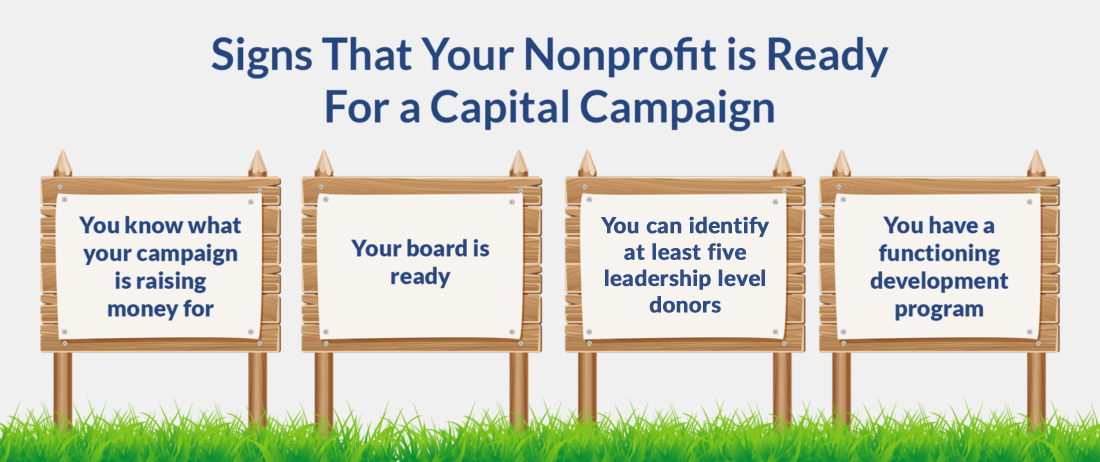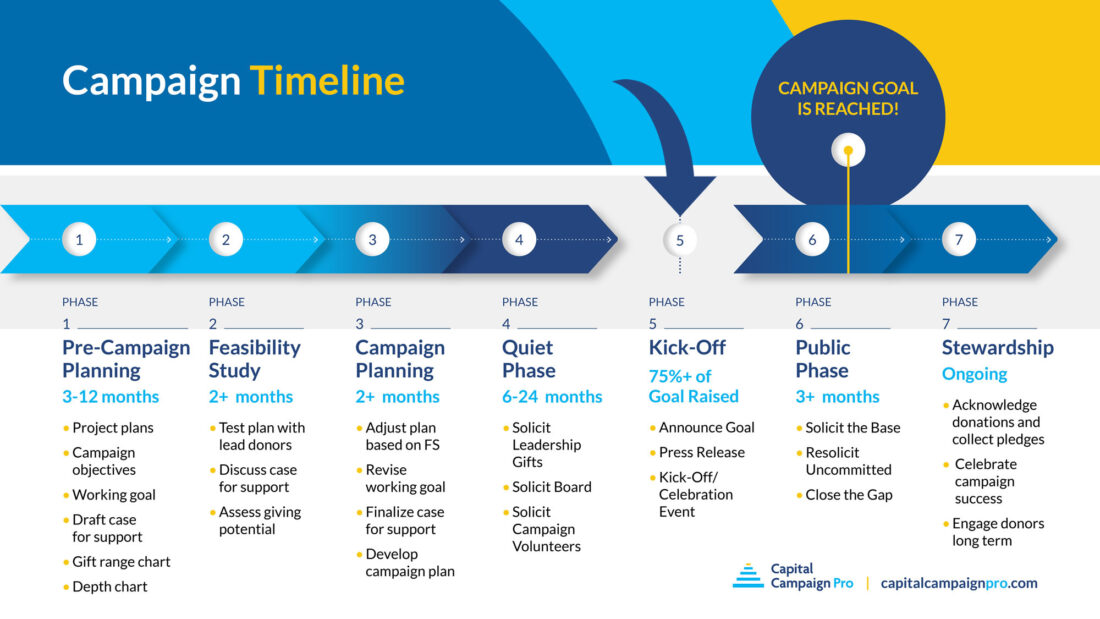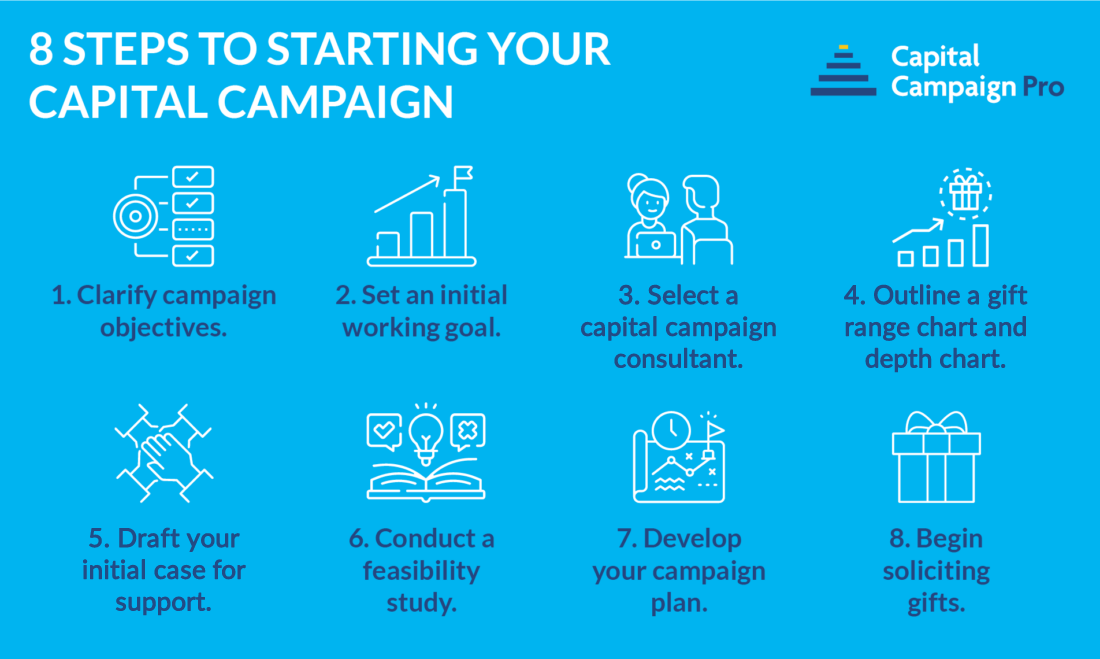Starting a Capital Campaign: A How-to Guide for Nonprofits

If your organization is planning to start a capital campaign, you are likely a little anxious. Your campaign is supposed to raise much more money than your organization has ever raised, and you wonder whether you have the donors you’ll need to reach your goal. You’re probably not sure exactly how to proceed. You know you can’t just hope and pray, but you don’t really know what steps you should take to get your organization ready for this huge fundraising campaign.
Capital campaigns are a tried and true form of fundraising. Organization after organization has started where you are now and has been successful in their quest to raise the money they need. But to do it well, you’ve got to understand how capital campaigns work and you have to be ready to go through the process of starting a campaign.
The right planning at the beginning of the campaign will make all the difference in how successful it is at the end. In this how-to campaign guide, we will spell out the essential steps you must take to start a successful campaign. We’ll cover:
- Key Signs That Your Nonprofit is Ready for a Capital Campaign
- Understanding When Your Capital Campaign Starts
- How to Start a Successful Capital Campaign: 8 Steps
Key Signs That Your Nonprofit is Ready for a Capital Campaign
Before you get going, make sure that your organization is ready at the most basic level. Here are four things to evaluate before you move ahead with your campaign planning.

- You know what your campaign is going to raise money for. This means you can articulate a clear and compelling need that the project/programs will address. Capital campaigns raise money for specific projects or programs that are over and above your operations, and before you start, you must know clearly what they are and how much they will cost. If you don’t, then you’ve got some work to do before you start your campaign.
- Your board is ready for a capital campaign. Your board members should know about your chosen project and be fully invested in the plans. They should also know that the campaign will require them to be fully involved and committed. If this is not the case, you should spend the time needed to bring your board fully on board with the plans.
- You can identify at least five donors connected to your organization in some way. These donors should be able to make six or seven gifts to your campaign. Don’t worry if they haven’t given to your organization at a high level yet.
- You have a functioning development program. Your program should empower you to track gifts and thank and steward donors. Those who staff the program should be able to help you undertake the campaign. It’s likely that you will hire additional staff to help with the campaign, but you will need a professionally run development program right from the start.
If, as you review these four signs, you see that you aren’t ready in one area or another, turn your attention to ramping up those aspects of your organizational readiness before moving on to the real start of your campaign.
Understanding When Your Capital Campaign Starts
We often get asked about campaign timelines. And everyone wants a simple, clear answer. But the reality is — it’s complicated. One thing we know for sure:
Your campaign starts long before you think it does.
In fact, the success of your campaign depends on how well you set your campaign up for success. The sooner you start planning for a campaign, the more successful you will be.
So, when does a capital campaign actually start?
- Is it when the board votes to approve a strategic plan with significant growth?
- Is it when a very small “core” committee meets for the first time to discuss campaign objectives?
- It is when the board approves initial funding to hire a campaign consultant for a feasibility study?
- Is it when the board approves the consultant’s recommendation to move ahead with a campaign?
- Is it when the first gift comes in that you count toward your campaign?
- Or is it when the campaign is announced to the public?
Let’s look at a typical capital campaign timeline:

You can see in the image above that campaigns are broken into seven phases. While each phase is important, the first three phases set the stage for your success, so don’t dive right into the solicitation phase of your campaign without going through those early steps.
To help you get started, let’s review these all-important initial phases and what they entail:
Pre-Campaign Planning
During this phase of the campaign, you will:
- Gather all of the information you currently have about your campaign and develop clear campaign objectives.
- Add costs to each of those campaign objectives. When added up, that will give you an initial sense of a preliminary goal for your capital campaign.
- Develop an early draft of your case for support, which makes a compelling argument for why the projects are important and the impact they will have on the communities you serve.
- Create a gift range chart to indicate the number of gifts you will need at each level to reach your goal.
- Develop a list of donors who might be prospects for the lead gifts on your chart.
Feasibility Study
With your preliminary campaign planning work done, you will test your plan with your largest donors through a feasibility study. This is how the study will work:
- Select the study model– traditional or Guided study.
- Engage a campaign consultant.
- Determine the people to be interviewed.
- Conduct conversations with approximately 30-40 people.
- Collate the results.
- Prepare the report.
- Present the report to your board.
The feasibility study will let you know approximately how much money you will be able to raise for your campaign and will offer other recommendations about readiness and the campaign process.
Campaign Planning
Using the results of the feasibility study, you will be able to develop a campaign plan that is based on concrete feedback from some of your largest donors. This phase is usually quite short but includes developing some critically important documents to guide your campaign. These include:
- Campaign policies
- Donor recognition plans
- Revised case for support
- Campaign budget
- Campaign timetable
- Staffing plan
Once the campaign plan is complete, you will be ready to start the Quiet Phase of your campaign during which you will ask those people closest to your organization and your largest donors. You can anticipate raising as much as 60% or 70%, or even more during this phase of your campaign.
When this Quiet Phase is complete, you will conduct your campaign Kick-Off. You may be confused by the term Kick-Off. The official Kick-Off of your campaign is not when the campaign starts. Rather, the Kick-Off marks the start of the public phase when you announce that you’ve already raised 70% or 80% (or even more) of your campaign goal and you’re ready to ask the public to help you raise the rest.
So, when does a campaign truly start?
At Capital Campaign Pro, we think that a capital campaign starts when your organization has decided to move forward with a specific plan to grow to the next level of operation. You may arrive at that moment through a strategic or long-range plan. Or external circumstances (like your lease getting canceled) may push your board to make decisions for future growth.
However you arrive at the moment when you know that your organization will have to raise significant money to accomplish a specific set of objectives that will move your organization forward, THAT’s the moment that your campaign really starts.
Why do we pin the start date of your campaign so early in the process?
Because the very best opportunities to engage and cultivate the people who have the potential to be your largest donors happen while your plans are still in their early stages.
How to Start a Successful Capital Campaign: 8 Steps
Now that you have a sense of how capital campaigns work and those all-important initial planning phases, we’ll give you some simple, steps for getting the ball rolling for your campaign. Follow these steps and you’ll find yourself on the road to success:

- Clarify your campaign objectives — make a list of all the things you’re going to raise money for through the campaign.
- Make the best guess at how much those campaign objectives will cost — this will be your initial working goal.
- Select a capital campaign consultant to guide you through the feasibility study process and help develop and implement your campaign plan.
- Outline a gift range chart and depth chart for an early indicator of whether you can achieve your working goal.
- Draft your initial case for support in bullet format — the case should answer the question of why people would want to give and why your organization is suited to this task.
- Conduct a feasibility study — we strongly suggest doing a Guided Feasibility Study to build relationships with key donors before finalizing your campaign plans.
- Develop your campaign plan, including a budget, timeline, campaign policies, donor recognition plan, and more.
- Start soliciting gifts for your campaign.
Get The Help You Deserve
At Capital Campaign Pro, we provide the guidance you need for a successful campaign. Our experienced advisors help organizations by guiding their campaigns every step of the way.
Our clients also have the chance to meet weekly with leaders from other organizations going through campaigns. In these peer group meetings, led by campaign experts, people share their campaign experience and discuss approaches to questions.
This approach allows the fundraisers in our community to find the support they need to take their campaigns over the finish line.
Starting a capital campaign is an exciting experience for any nonprofit, whether it’s your first campaign or you’re a seasoned veteran. However, you have to tread carefully to ensure you’re setting yourself up for success.
Use the guidance outlined above to put your best foot forward with your campaign, and remember that you will benefit from working with an expert campaign advisor who can guide you through the campaign process.
Want to keep learning about the world of capital campaigns? Check out these resources:





Leave a Comment